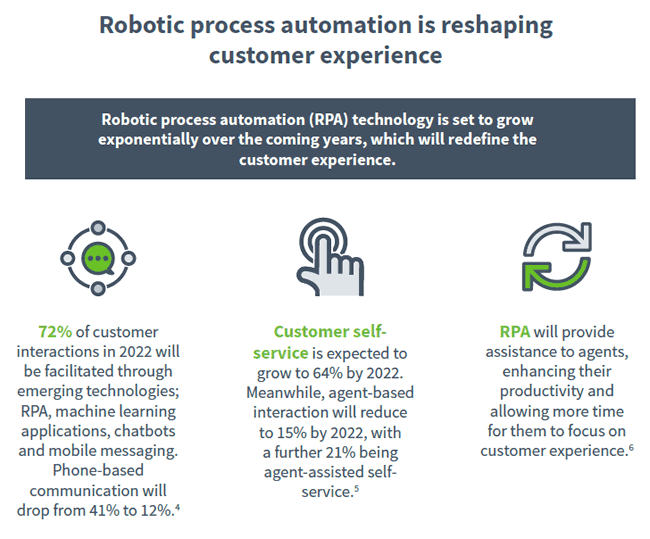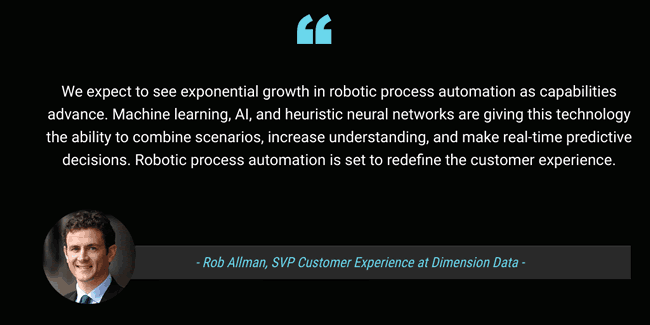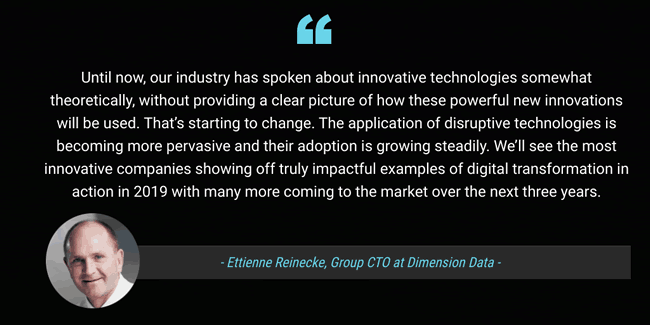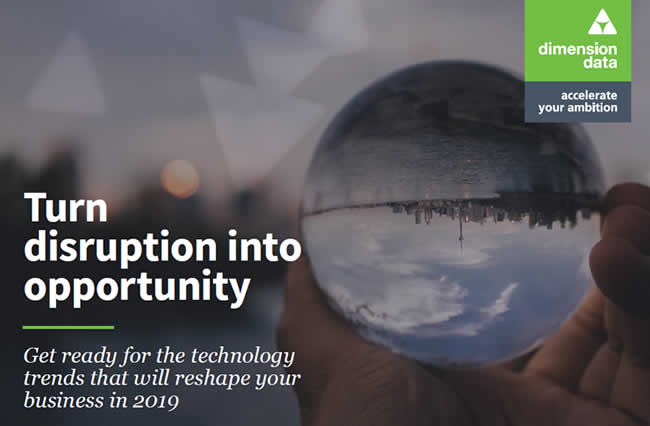The technology trends 2019 report by Dimension Data offers ample forecasts and trends across various domains. The company also selected five trends that will determine the business technology landscape in 2019. The first spot is for robotic process automation (RPA). According to Dimension Data 2019 is the year we start seeing RPA reshaping customer experience.
On top of the annual analyst predictions ample vendors, system integrators, service providers and other IT companies are sharing their views on the main technology trends they see for 2019 – and of course beyond, since trends don’t tend to follow the Gregorian calendar, sometimes building upon analyst findings with own insights and feedback from their customers.
One of them is technology integrator and managed services provider Dimension Data that has a long history of research, trend watching and reports as part of its mix. This year it isn’t any different and we get a bunch of insights, including aggregated ones from other sources, into areas such as cybersecurity, customer experience, infrastructure, digital business, services and the digital workplace. Digital transformation is obviously a keyword in it all.
As you can download everything nicely in an eBook by visiting the technology trends 2019 homepage where you can also dive deeper per topic, we focus on a summary of some main technology trends 2019 in the view of Dimension Data.
Major trend: RPA reshaping customer experience (CX)
While topics such as conversational AI, edge computing and – of course – IoT feature among the many technology trends, Dimension Data chose to highlight fives ones, one for each topic.
And as you could already tell from the small summary on top of this post robotic process automation was put on top of that list, more specifically in a scope of customer experience trends for 2019 (including the contact center).
Dimension data foresees a ‘huge growth in robotic process automation, due to its power to reduce cost, speed up customer handling, and make interactions more personalized’ as you can also read in the overview of the ‘Customer experience trends in 2019’ by Senior VP Customer Experience, Rob Allman. The screenshot from the ‘customer experience trends’ infographic – which you can download in PDF – below gives a few additional insights and data points.

With its statement that ‘72% of customer interactions in 2022 will be facilitated through emerging technologies such as RPA, machine learning applications, chatbots and mobile messaging’ Dimension Data refers to findings from Gartner which are covered here (and where you also can read that by 2021, 15 per cent of customer service interactions are expected to be completely handled by AI).
The statement that RPA will provide assistance to agents, enhancing their productivity and allowing more time for them to focus on customer experience’ comes from other somewhat older ‘top customer experience trends’ research.
For Dimension Data it’s clear: we’ll see RPA reshaping customer experience as we know it. And it’s not your traditional RPA but the kind of RPA that’s increasingly referred to as intelligent automation. The exponential growth in robotic process automation with the additional capabilities provided by machine learning, AI, and heuristic neural networks enable companies to combine scenarios, increase insight and make real-time predictive decisions about their customers’ needs and behavior.

Industry-wide disruption as innovative companies see long-term projects bear fruit
That’s enough attention for CX and RPA reshaping customer experience; now a quick look at those other technology trends 2019. Yet, first a more overall statement.
Ettienne Reinecke, Group CTO, expects digital transformation to become a reality in 2019. He predicts a major, industry-wide disruption as innovative organizations see that long-term projects are going to pay off.
The often mentioned – but rarely completed – transformation projects come to life thanks to breakthrough technologies that are becoming increasingly mature, such as AI, ML and, indeed, RPA.
Reinecke says that until now, the industry has talked in a somewhat theoretical way about innovative technologies without giving a clear picture of how they can be used, giving examples such as analytics, machine learning, AI, blockchain and containers.
This is now starting to change he claims. Disruptive technologies are being used more and more and the most innovative companies will show impressive examples of digital transformation in action in 2019 with many more expected in the next three years.
They will then become so firmly anchored in the core processes and technologies we use that we will start to consider them as your commonplace technologies, Reinecke thinks. For him 2019 is the year that the so-called trailblazers leave the fast followers behind, with some significant power shifts between sectors ahead. We’ll see.

More technology trends 2019 per Dimension Data
The other technology trends 2019 that Dimension Data highlights as five new trends that will determine the business technology landscape in 2019 (so, with RPA reshaping customer experience being numero uno):
Organizations focus on cloud-based cyber security platforms
The frequent high-profile cybersecurity breaches of 2018 will ensure that there will be more cloud security providers in 2019 Dimension Data says. Cloud-based security systems are built with open APIs, which means that security teams can integrate new technologies into the platform quickly and relatively easily. This ensures that customers keep an eye on the rapidly changing threat landscape.
Infrastructure becomes programmable from start to finish
According to Dimension Data’s technology trends 2019 overview companies will subscribe to multiple cloud platforms and increasingly use Software-as-a-Service (SaaS).
End-to-end programmability means that organizations can quickly adapt to changes in the business and demand more from their applications and data.
Applications are becoming more intelligent and tailor-made
In 2019 we should see applications that collect input from users and make changes to their own functionality to improve the user experience. AI and machine learning will play an important role in assisting employees to work more productively.
The value of data becomes the core of the digital transformation
Last but not least the technology trends 2019 announcement states – or reminds – that the focus will increasingly shift to the actual value of data, which leads to a new quest to embed telemetry, and to collect and enrich data.
Ultimately, data forms the core of the digital transformation and becomes the source of new revenues that transcends traditional revenues and that will lead to a change in information architectures. That’s indeed where a lot of change is happening since the good old days of information management and even big data.
All images belong to their respective mentioned owners.


